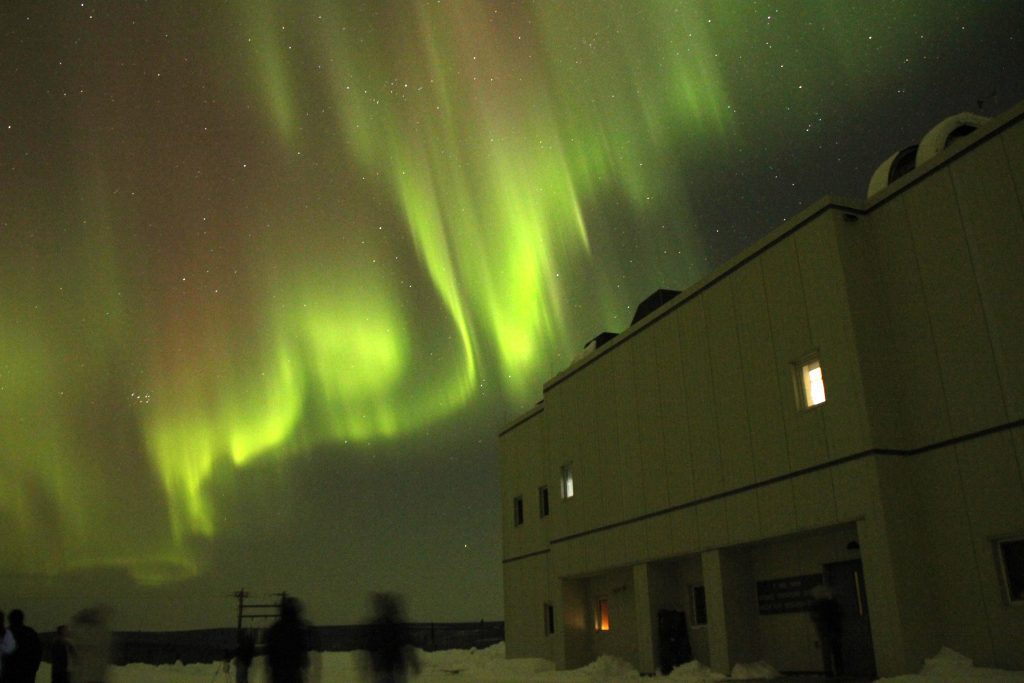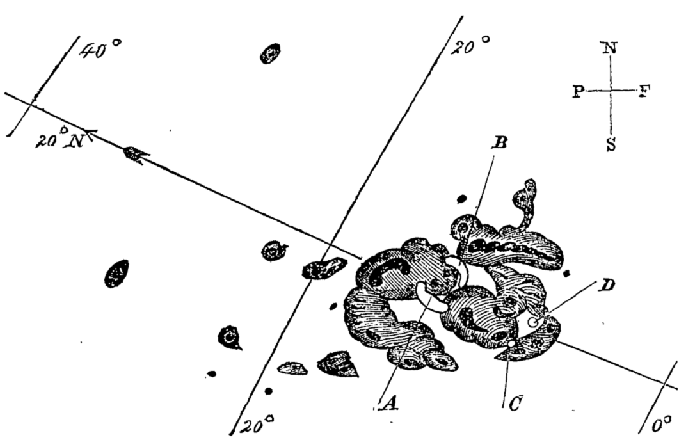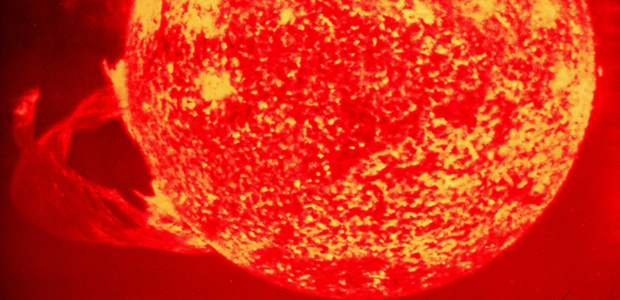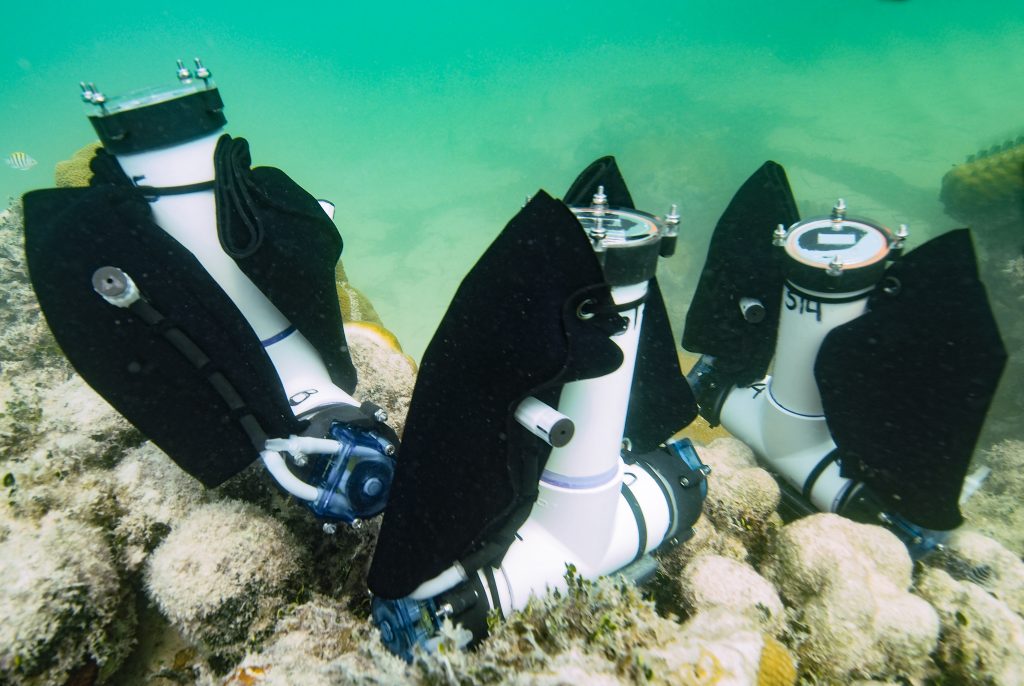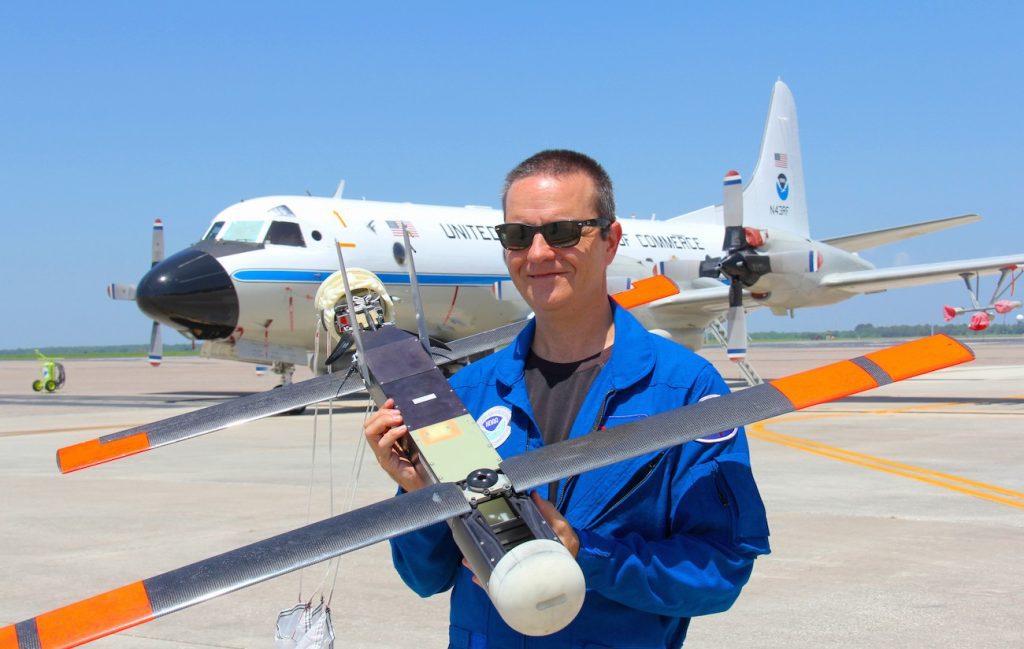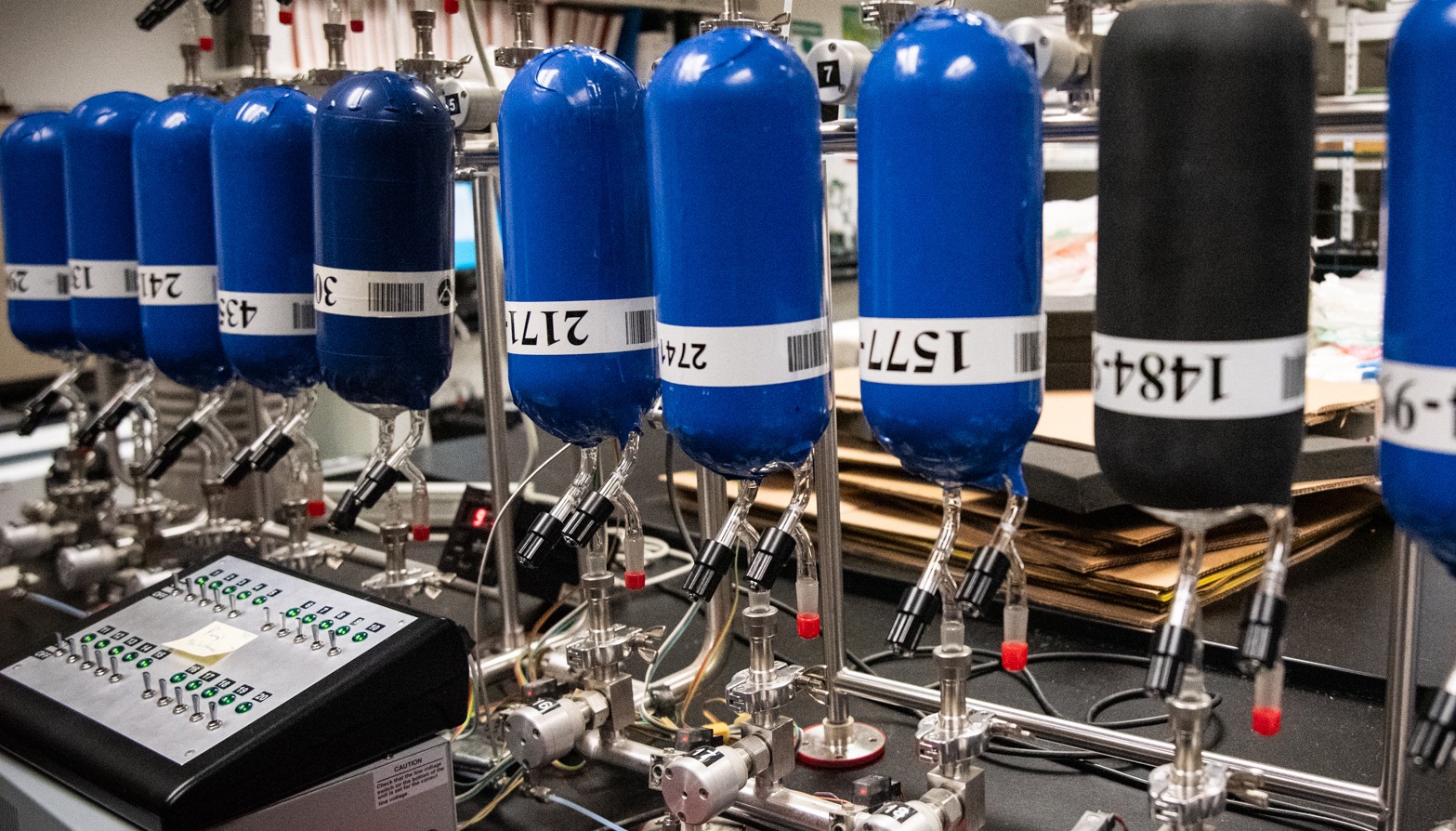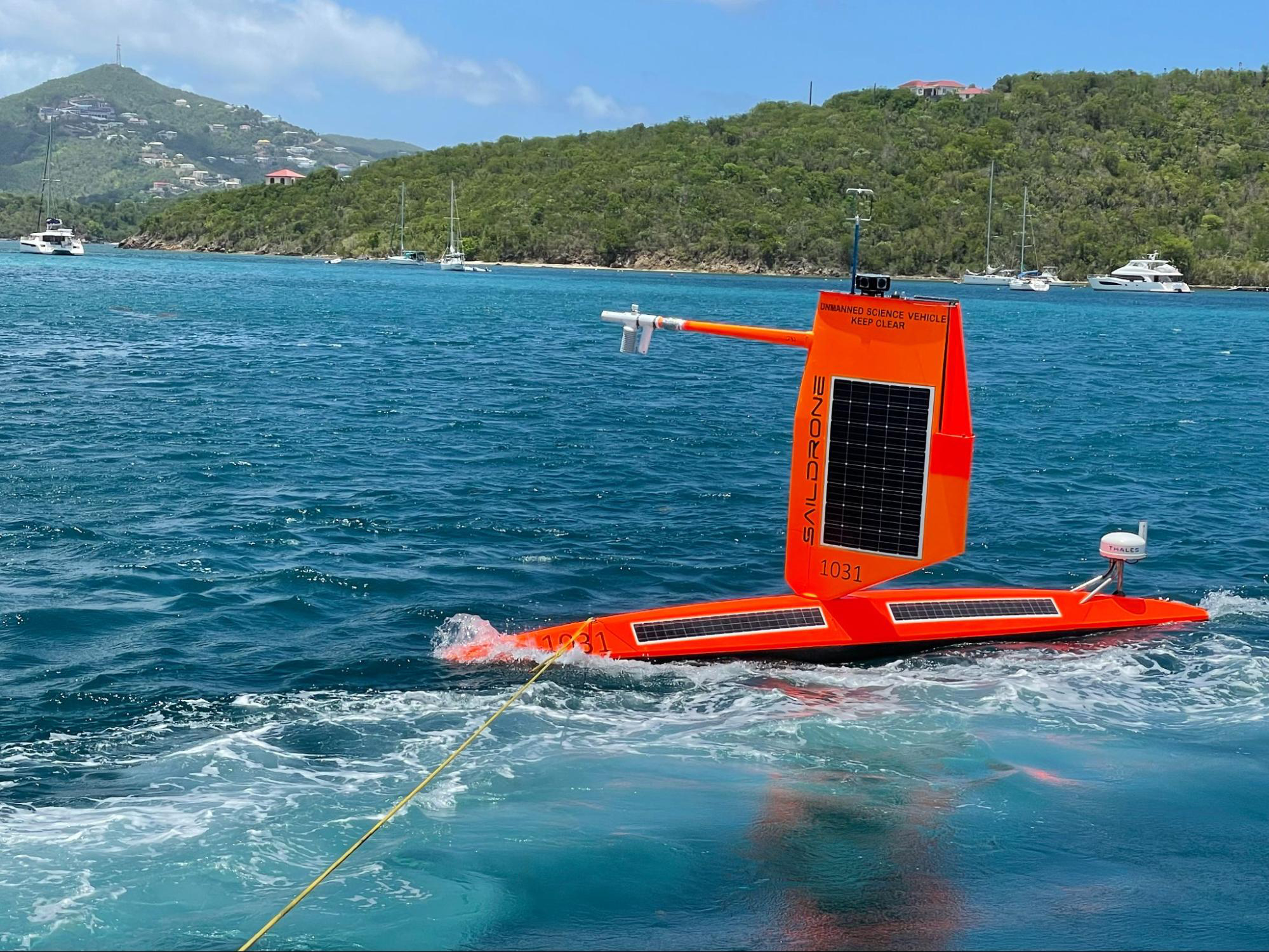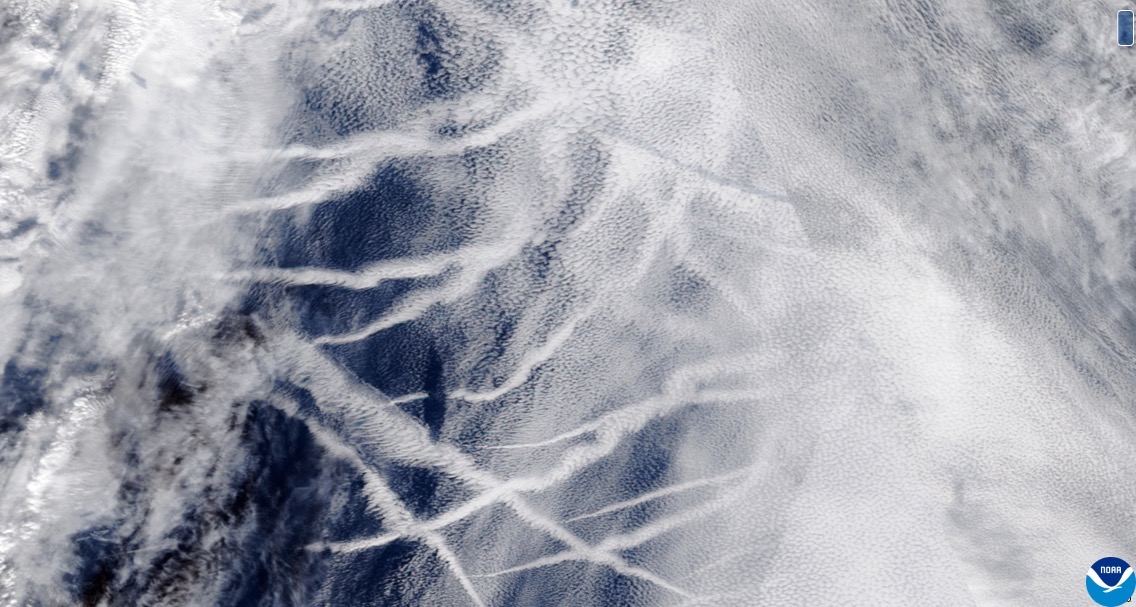Independent astronomer records massive solar storm in 1859
Contact: Monica Allen, monica.allen@noaa.gov, 301-734-1123
Way back before we had the Internet and telephones and electrical wiring – more than 150 years ago – scientists learned how solar flares can play havoc with manmade technologies. They also connected solar flares to the fantastic displays of auroral light, usually seen only at far northern and southern latitudes. And this discovery was completely by accident.
Subsurface autosamplers ride along on a large moored buoy to help validate and calibrate its data. The carbon dioxide buoy provides long-term data on how ocean acidification is affecting waters near Cheeca Rocks in the Florida Keys National Marine Sanctuary. Credit: NOAA
Englishman Richard Carrington is credited with the key observation in 1859 that connected solar flares with communications disruptions as well as the aurora borealis. Carrington was a wealthy astronomer who dutifully recorded sunspots in his observatory at his estate in Redhill not far from London.
His father owned the Royal Brewery in a nearby town and had urged his son to attend seminary. Richard, however, was more interested in math and astronomy. After completing his studies at Trinity College, he went to work at the University of Durham observatory. After three years there, he was frustrated with the university’s inability to purchase new instruments for the observatory. In 1852, he decided to resign and use his family’s wealth to build his own house with an attached observatory and state-of-the-art telescope.
He completed his observatory in 1854, employed an assistant, and worked on cataloging stars. One project, a catalog of circumpolar stars, earned him a gold medal from the Royal Astronomical Society in 1859. But he was also interested in the sun.
The Carrington Event
Working away in his observatory on Sept. 1, 1859, he was doing one of the most mundane things that scientists do – collecting data – when a massive solar flare exploded. He was lucky enough to be in the right place at the right time, and so this first human-observed solar flare is known as the Carrington Event.
Lacking anything like an X-ray telescope, which modern astronomers use to study the sun, he worked by projecting an image of the sun from his optical telescope onto a large white screen. Looking at the sun directly through the telescope could have damaged his eyes. The shadows of crossed wires on the screen allowed him to time the transit of sunspots across the surface of the sun.
We know now that sunspots are caused by intense magnetic activity, but in 1859, the nature of these darks spots on the bright solar surface was not well understood. Nonetheless, Carrington recorded the date and time that sunspot images intersected with the shadows of his wires. He also drew diagrams of the spots he observed.
On Sept. 1, he “was engaged at the time in counting from a chronometer and recording the contacts of the spots with cross-wires used in the observation, when…two patches of intensely bright light broke out,” he wrote in a paper published later in the Monthly Notices of the Royal Astronomical Society. These patches of light quickly intensified.
Carrington’s first thought, he wrote, was that light had penetrated a hole in his screen. But, as the bright light moved with the sunspot image, he realized there was no hole in his screen.
“I thereupon noted down the time by the chronometer, and seeing the outburst to be very rapidly on the increase, and being somewhat flurried by the surprise, I hastily ran to call someone to witness the exhibition with me, and on returning within 60 seconds, was mortified to find that it was already much changed and enfeebled. Very shortly afterwards the last trace was gone,” he wrote in his journal article.
Accidental observation leads to discovery
Carrington’s careful observations and data collection are what enabled scientists to connect the solar flare to the surprising events that followed on its heels. Since 1859, scientists have observed thousands of solar flares, but none have matched the intensity of the Carrington Event. Carrington’s observations also opened many new questions for astronomers. Much of what we know now about how solar flares interact with the Earth’s atmosphere and magnetic field started with those questions.
Within 18 hours of Carrington’s solar flare, Earth was engulfed in perhaps the largest geomagnetic storm ever, which sent compass needles swinging erratically and lit the skies with shimmering auroras.
The legacy of Carrington’s work continues today through research conducted by NOAA’s Space Weather Prediction Center.
Howard Singer, Ph.D., chief scientist in the NOAA Space Weather Prediction Center’s Space Weather Services Branch, explains that fast-moving energetic particles and slower-moving solar matter erupt from the sun’s atmosphere during a solar flare. The solar matter thrown into space is known as a coronal mass ejection, or CME.
“It’s like a blob of material exploding out into the solar wind and travelling as much as five or six times faster than the typical background solar wind,” Singer says. When a CME hits the Earth’s magnetopause, the boundary between Earth’s magnetic field and the solar wind, interactions between solar matter and Earth’s own magnetic fields cause a geomagnetic storm. These storms can interfere with our power grids, and communication and navigation systems. Interference can range from minor to extreme, depending on the intensity of the storm.
Telegraphs go down, skies light up
In 1859, there were no power grids, and our only telecommunication system was the telegraph. But the solar storm had its impacts even then. Telegraph operators were among the first to notice the effects of the massive solar flare and subsequent geomagnetic storm. Operators in North America and Europe were unable to send messages. Some received electric shocks from their equipment. In some cases, sparks set paper near the telegraph ablaze.
Singer has an historical record of messages between two operators in Boston and Portland:
Boston (to Portland operator) – “Please cut off your battery entirely from the line for fifteen minutes.”
Portland – “Will do so. It is now disconnected.”
Boston – “Mine is also disconnected and we are working with the auroral current. How do you receive my writing?”
Portland – “Better than with our batteries on. Current comes and goes gradually.”
Boston – “My current is very strong at times, and we can work better without batteries, as the aurora seems to neutralize and augment our batteries alternately, making the current too strong at times for our relay magnets. Suppose we work without batteries while we are affected by this trouble?”
With solar matter crashing around the Earth’s magnetic field, like rough surf around a ship’s bow, the 1859 solar storm also pushed the visible range of the aurora borealis as far south as the Caribbean. Newspaper accounts captured what people saw in the night sky.
“Early in the evening from the east there came a faint light, like that preceding the rising moon, while in the west a delicate crimson seemed to be thrown upwards, as if from the sun, long since gone down,” reported the Cincinnati Daily Commercial on Sept. 1, 1859. “Later, these strange fires overran the entire heavens – now separating into streamers, gathered at the zenith, and forming a glorious canopy – then spreading evenly like a vapor, shedding on all things a soft radiance.”
The New Orleans Daily Picayune reported on Aug. 29, 1859, that crowds gathered on street corners to watch the aurora. Some feared that it was a warning of an impending disaster or epidemic. People in Boston assumed that their sky had reddened due to a fire until the red color changed to green spires of light, according to the Boston Transcript on Sept. 5, 1859.
Predicting space weather today
Today, reliance on 21st century communications, navigation and power grids necessitates that we vigilantly monitor solar flare activity, Singer explains. NOAA’s Space Weather Prediction Center in Boulder, Colo., is the nation’s official source for forecasts, warnings, and alerts about space weather.
Geomagnetic storms triggered by solar flares and coronal mass ejections have the potential to disrupt:
· GPS navigation systems;
· electrical power grids;
· airline communications; and
· military and environmental satellites.
The NOAA Space Weather Prediction Center monitors solar activity and issues forecasts and alerts when solar flares and CMEs threaten the operation of any of these systems. Operators can then take steps to mitigate or avoid damage. Solar activity peaks about every 11 years. The next peak is expected in 2013.
Space weather prediction center scientists and partners at other federal and academic institutions recently improved the forecasting model they use to make predictions. Their new model enables forecasters to time the impacts of solar activity to within a 12-hour window. The previous model was accurate within a 30-hour window. Read more about the new model.
To learn how the NOAA Space Weather Prediction Center keeps a close watch on the sun, read When the sun acts up, NOAA knows why, an online NOAA feature story
On the Web:
Richard Carrington’s paper in the Monthly Notices of the Royal Astronomical Society
Historical accounts of the 1859 solar storm, compiled by a NASA scientist
NOAA Scientists Look Beyond Earth to Understand Auroras
